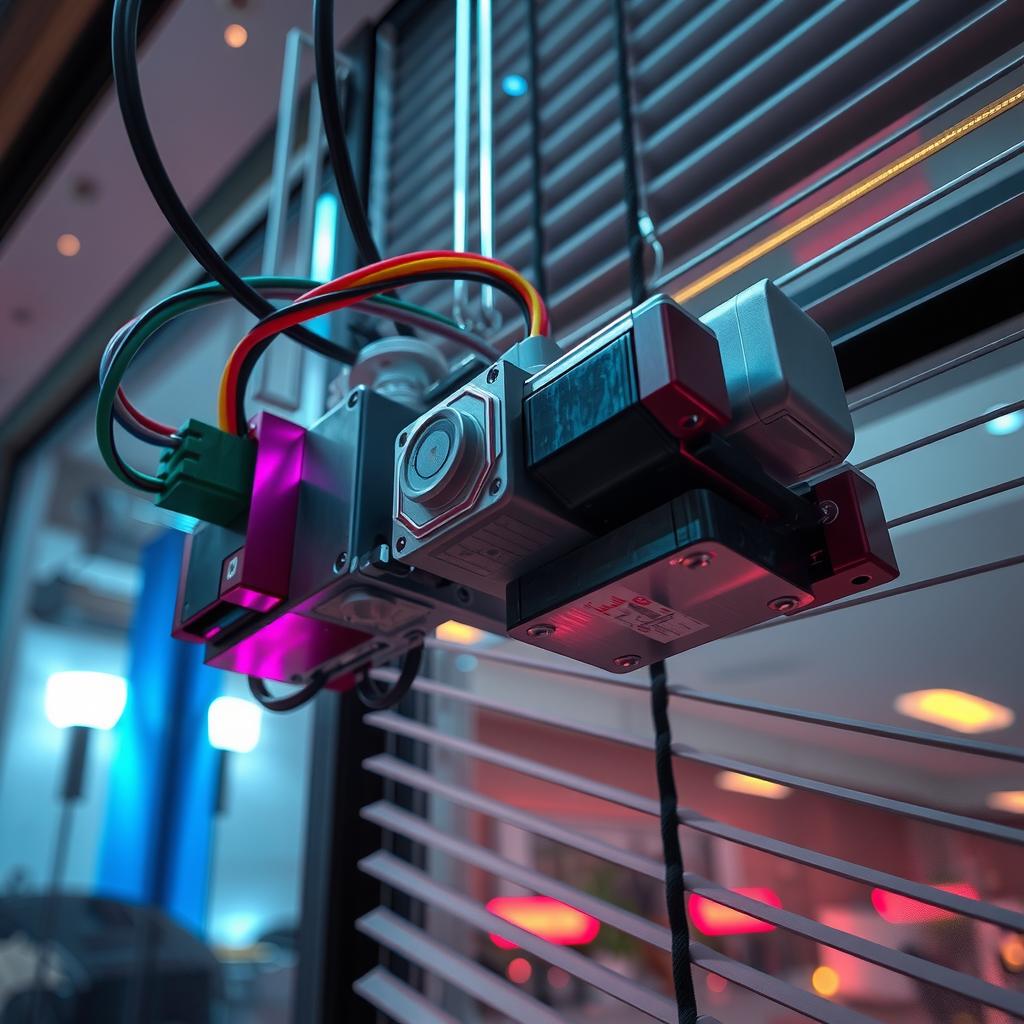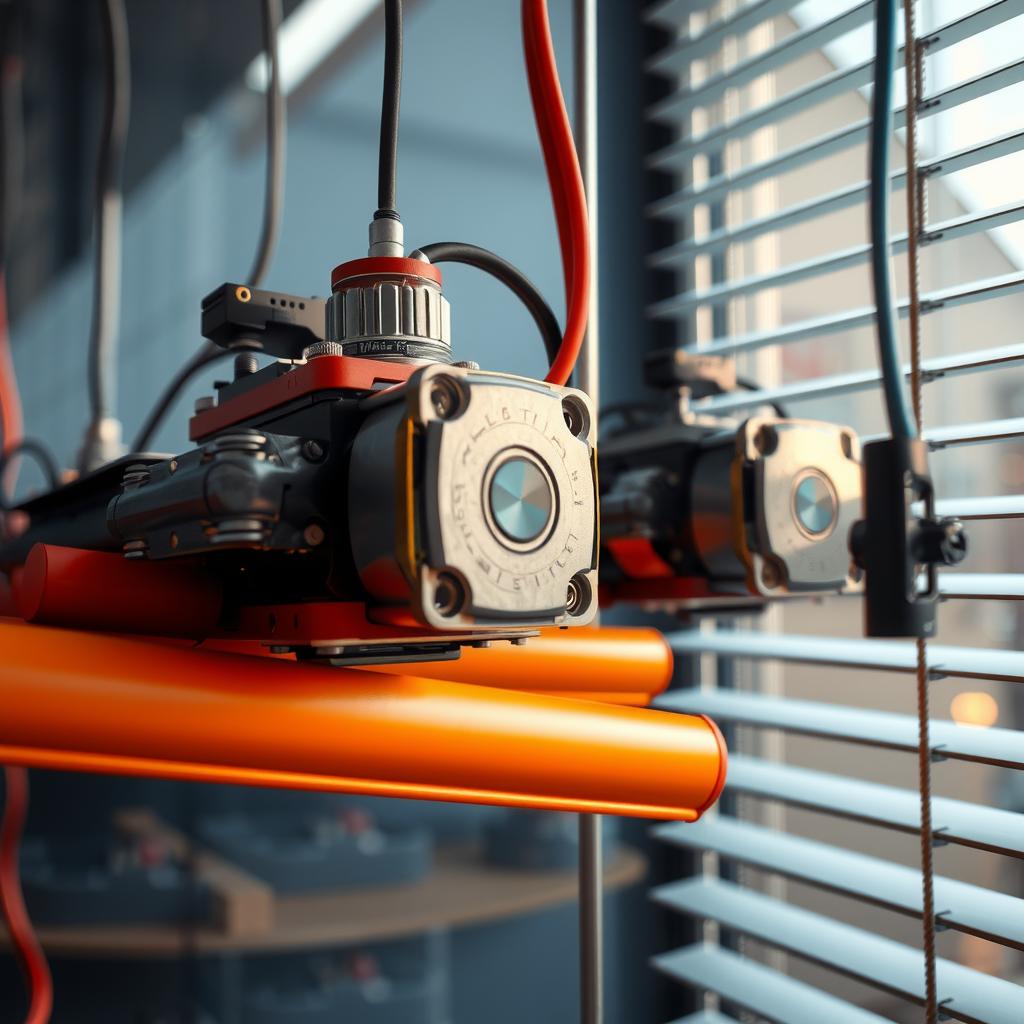In an age where smart home technology is revolutionizing the way individuals interact with their living spaces, one question looms large: How can homeowners enhance comfort and energy efficiency through innovative solutions? The answer lies in programming servo motors for automated blinds. These unassuming devices are becoming increasingly popular as a means of automating window coverings, providing not just convenience but also significant savings on energy costs. With the ability to control light levels and privacy at the touch of a button, automated blinds equipped with servo motors represent a leap forward in home automation.
Programming these sophisticated components may seem daunting at first glance; however, understanding the functionality of servo motors can empower DIY enthusiasts and tech-savvy homeowners alike to tackle this project confidently. By integrating motor control into their window treatment systems, users can create tailored solutions that respond to time-of-day changes or ambient light conditions. The versatility of servo motors, paired with straightforward programming techniques, opens up endless possibilities for customization—transforming ordinary blinds into responsive elements of the smart home ecosystem.
Moreover, as more people seek out sustainable living options and look to reduce their carbon footprint, implementing automation solutions like these becomes essential. Not only do automated blinds enhance day-to-day experiences by allowing seamless management of natural lighting; they also contribute to overall energy efficiency by minimizing reliance on artificial lighting and climate control systems when unnecessary exposure occurs.
This blog post will explore how anyone interested in DIY projects can leverage technology by learning how to program servo motors effectively for their own automated blind systems. From selecting appropriate hardware components to coding simple commands that dictate movement patterns based on user preferences or environmental stimuli—readers will find practical insights aimed directly at simplifying this process while maximizing benefits. With patience and creativity as guiding principles, mastering the art of using servo motors in conjunction with automated blinds is well within reach—and could very well lead readers down an exciting path toward a smarter future within their homes.

Key Points:
-
Selecting the Right Servo Motors: Understanding Specifications and Compatibility
In the realm of automated blinds, choosing the appropriate servo motors is crucial for achieving optimal performance. Homeowners should consider various specifications such as torque, speed, and size to ensure that the selected motors can effectively manage their window coverings. By aligning these technical aspects with personal preferences and existing smart home technology, individuals can enhance their automation solutions while ensuring longevity and reliability in operation. -
Crafting Intuitive Controls for Automation: Enhancing User Experience
Effective programming of servo motors empowers users to create intuitive controls that elevate convenience within their living spaces. Whether through smartphone applications or voice-activated systems, integrating user-friendly interfaces ensures seamless interaction with automated blinds. This capability allows homeowners to quickly adjust settings based on changing light conditions or personal habits, thus promoting energy efficiency by optimizing natural light usage throughout different times of day. -
Implementing Energy-Efficient Systems: Maximizing Comfort and Functionality
The integration of servo motors into smart home technology not only simplifies daily routines but also contributes significantly to energy savings. As automated blinds respond dynamically to environmental changes—such as temperature fluctuations or varying sunlight—homeowners can enjoy a more comfortable living experience while reducing reliance on artificial heating or cooling methods. Therefore, understanding how to program these advanced tools becomes essential for anyone looking to modernize their homes sustainably through effective motor control strategies in DIY projects or comprehensive automation setups.

Understanding Torque Requirements for Automated Blinds
The Importance of Torque in Servo Motor Selection
When selecting servo motors for automated blinds, understanding torque requirements is essential. Torque refers to the rotational force that a motor can provide, which directly impacts its ability to lift and lower window coverings effectively. In this context, the necessary torque will depend on several factors including the weight of the blinds, their size, and any additional resistance presented by hardware or environmental conditions such as wind. For instance, heavier materials like blackout shades may require a higher torque rating compared to lighter fabrics. It is advisable to consult manufacturer specifications or even perform calculations based on blind dimensions and material properties when determining the appropriate servo motor torque needed. Additionally, users should consider whether they desire adjustable tension settings within their automation solution; some modern servo motors allow for programming features that enable fine-tuning of performance under varying load conditions. By selecting an adequately rated servo motor with sufficient torque capabilities, one can ensure reliable operation and longevity in automated systems designed for smart home technology.
Speed Considerations in Motor Control
Balancing Speed with Functionality
Speed is another critical factor when choosing servo motors for automated blinds since it dictates how quickly these window coverings open or close. While faster movements might seem desirable for convenience purposes—such as rapidly transitioning from daylight streaming into a room to privacy at night—it’s crucial not to overlook functionality and safety aspects associated with speed adjustment features available in many modern servo motors. If blinds operate too quickly without proper control mechanisms in place, there could be risks of damaging both the blinds and surrounding furnishings due to abrupt stopping or collisions against obstacles like windowsills or furniture pieces. Therefore, it’s recommended that homeowners prioritize servo motors capable of variable speed settings alongside smooth acceleration profiles tailored specifically towards their unique installation configurations within DIY projects involving automation solutions aimed at enhancing energy efficiency while maximizing user comfort.
Compatibility with Smart Systems
Integrating Servo Motors into Modern Home Automation
As more households embrace smart home technology initiatives aimed at increasing convenience through automation solutions—including controlling lighting levels via remote access—compatibility becomes paramount when selecting suitable servo motors for automated blinds installations. Many contemporary servo models offer built-in Wi-Fi connectivity options enabling seamless integration into existing ecosystem platforms such as Google Home or Amazon Alexa systems; this ensures ease-of-use across various applications including scheduling daily routines related to window covering adjustments according local weather patterns throughout each day/week cycle without requiring manual intervention regularly from residents themselves! When investing time researching ideal products suited best fit preferences regarding style choices alongside functional requirements like those mentioned previously (e.g., torque/speed), consumers should analyze product reviews focusing specifically on compatibility ratings associated particular models before making purchase decisions ultimately influencing overall satisfaction derived out utilizing new implementations introduced via advanced technologies available today affecting daily living experiences positively over time significantly!
Energy Efficiency Factors
Selecting Energy-Efficient Solutions for Sustainable Living
Energy efficiency plays an increasingly significant role in today’s eco-conscious society where cost-saving measures align closely with sustainable living practices adopted by homeowners globally through careful selection process involved whilst identifying optimal types/brands specific (Servo Motors) applicable respective needs pertaining direct involvement tied toward operating devices intended improve quality life indoors/outdoors alike! Consumers must take note potential energy consumption rates indicated either specifications provided publicly online—or recommendations given firsthand from trusted sources who have experience using similar products successfully minimizing waste generated during operations achieving desired outcomes accordingly – all contributing indirectly fostering healthier planet ecology long-term basis collectively amongst individuals participating actively partake journey exploring innovative ways enhance efficiency incorporating environmentally friendly components whenever feasible possible aligning overall aspirations toward reducing carbon footprints substantially over lifespan enjoyed benefits accrued automating everyday tasks seamlessly resulting enhanced quality leisure moments shared among family members friends alike embracing interconnected lifestyles harmoniously together paving pathways future generations inherit brighter tomorrow awaiting them ahead steadily moving forward united vision achieved collaboratively working hand-in-hand tirelessly striving excellence proven practices established firmly ground guiding principles underpinning progress made thus far illuminating paths success driven purpose resolve steadfast dedication ensuring goals met fulfilled completely confidently assured knowing made right choices along way every step taken counts significantly along journey embarked upon passionately pursuing dreams realized fully fruition ultimately leading transformative change witnessed lives impacted forevermore inspiring others follow footsteps laid down meticulously pave roads brighter futures envisioned hopefully soon come reality each passing moment cherished deeply!
Innovative Programming Strategies for Enhanced Comfort
Understanding the Role of Automation in Modern Living
In today’s fast-paced world, automated blinds have emerged as an essential component of smart home technology, providing enhanced comfort and energy efficiency. One of the key programming techniques involves utilizing servo motors to create intuitive controls that allow these window coverings to respond dynamically to environmental changes. By implementing sensors that detect light levels or temperature fluctuations, users can program their automated blinds to adjust automatically throughout the day. For instance, during peak sunlight hours, the blinds could lower themselves to mitigate heat gain and glare while raising during cooler periods to take advantage of natural light. This level of automation not only improves user convenience but also contributes significantly toward energy savings by reducing reliance on artificial heating or cooling systems.
Customization through Smart Home Integration
The integration of servo motors within a broader smart home framework offers unparalleled opportunities for customization in controlling automated blinds. Through various programming approaches such as event-driven triggers and scheduled routines, homeowners can tailor their window coverings’ behavior based on individual preferences or specific conditions. For example, a family might choose for their living room blinds to open gradually at sunrise and close again at sunset without any manual intervention required. These automation solutions empower users with greater control over their living environment while enhancing overall functionality. Additionally, compatibility with voice-controlled assistants allows commands like “close the bedroom curtains” which seamlessly integrates into daily routines.
Enhancing User Experience through Feedback Mechanisms
To further refine user interaction with automated blinds, incorporating feedback mechanisms proves invaluable. By using data from installed sensors monitoring environmental changes alongside programmed schedules, homeowners can ensure optimal performance from their servo motors driving blind operations. If excessive sunlight is detected despite closed shades—indicating insufficient coverage—the system could prompt an automatic adjustment or alert users via a mobile app notification prompting them for action if necessary. Such intelligent responsiveness enriches user experience while fostering trust in automation technologies employed in modern homes.
DIY Projects: Empowering Users with Control
For those interested in hands-on involvement with technology, creating customized solutions involving servo motors for automated blinds represents an exciting DIY project opportunity. Enthusiastic individuals may experiment with different configurations combining various sensor types along with programmable microcontrollers that regulate motor control effectively based on real-time inputs received from external environments such as outdoor weather patterns or indoor lighting conditions—enhancing both practicality and aesthetic appeal within spaces where they are applied! Moreover integrating cost-effective components makes it feasible even for budget-conscious homeowners aiming towards upgrading traditional window coverings into sophisticated yet practical assets promoting sustainability alongside innovation!
By understanding these innovative programming strategies involving servo motors and other technological advancements surrounding automated blind systems today; one not only achieves improved livability but also embraces a forward-thinking approach aligning perfectly well within contemporary sustainable practices thriving across global communities ensuring brighter futures ahead!
Integrating Servo Motors into Smart Home Systems
A Comprehensive Approach to Modernizing Your Living Space
Integrating servo motors into smart home systems represents a significant leap towards enhanced automation solutions and energy efficiency. These compact, high-performance devices can be seamlessly incorporated into existing technologies, offering homeowners an innovative way to modernize their living spaces while optimizing functionality. For instance, the implementation of automated blinds controlled by servo motors allows for precise adjustments according to environmental changes or user preferences. This not only contributes to improved comfort levels but also positively impacts energy consumption by minimizing reliance on heating and cooling systems.
The integration process begins with understanding the specific needs of your household. Whether it’s implementing motor control for window coverings or automating other elements within your smart home technology ecosystem, careful planning is essential. First, identify areas where automation would provide tangible benefits; this could range from managing natural light through automated curtains to controlling appliances like fans and lights via programmable settings linked to those same servo motors. Next, one should consider how these components will interface with existing platforms—whether through Wi-Fi connectivity or via dedicated hubs that streamline communication between devices.
Programming is a critical aspect when integrating servo motors into smart home systems. Most servo motor applications allow for straightforward programming options that cater specifically to personal routines and schedules. Homeowners might explore DIY projects as a means of customizing their setups further; various online resources provide detailed guides on configuring these devices effectively without requiring extensive technical expertise. The ability to program timers or set conditions based on factors such as sunlight exposure elevates the overall utility of servo motors, creating an intelligent environment that responds dynamically in real time.
Moreover, users must carefully consider power management strategies during installation processes since energy efficiency remains a primary concern in modern households striving for sustainability. Utilizing low-power servo motors, alongside sensors that detect room occupancy or ambient light levels can lead not only to convenience but also considerable savings on utility bills over time—a crucial factor in today’s eco-conscious society.
In conclusion, incorporating servo motors into smart home technologies offers promising opportunities for personalization and enhanced operational efficiency within living spaces. By taking actionable steps toward thoughtful integration—including planning optimal placements for automated blinds and utilizing effective programming techniques—homeowners can create environments tailored precisely to their lifestyles while embracing cutting-edge advancements in technology.
Frequently Asked Questions:
Q: What are the benefits of using servo motors in automated blinds?
A: The use of servo motors in automated blinds enhances convenience and energy efficiency. By automating window coverings, homeowners can optimize natural light usage throughout their living spaces, reducing reliance on artificial lighting and improving overall energy management.
Q: How can I program servo motors for my smart home technology setup?
A: Programming servo motors involves understanding motor control techniques and integrating them with your existing automation solutions. By utilizing specific programming languages or platforms designed for smart home applications, users can create customized settings that allow their blinds to respond dynamically to environmental changes such as light intensity or temperature.
Q: Are there DIY projects available for installing servo motors in automated blinds?
A: Yes, numerous DIY projects guide homeowners through the installation of servo motors in automated blinds. These projects often provide step-by-step instructions, recommended components, and tips for successful integration into a smart home system. Engaging in these initiatives not only fosters creativity but also empowers individuals to enhance their living environments efficiently.

Add a Comment